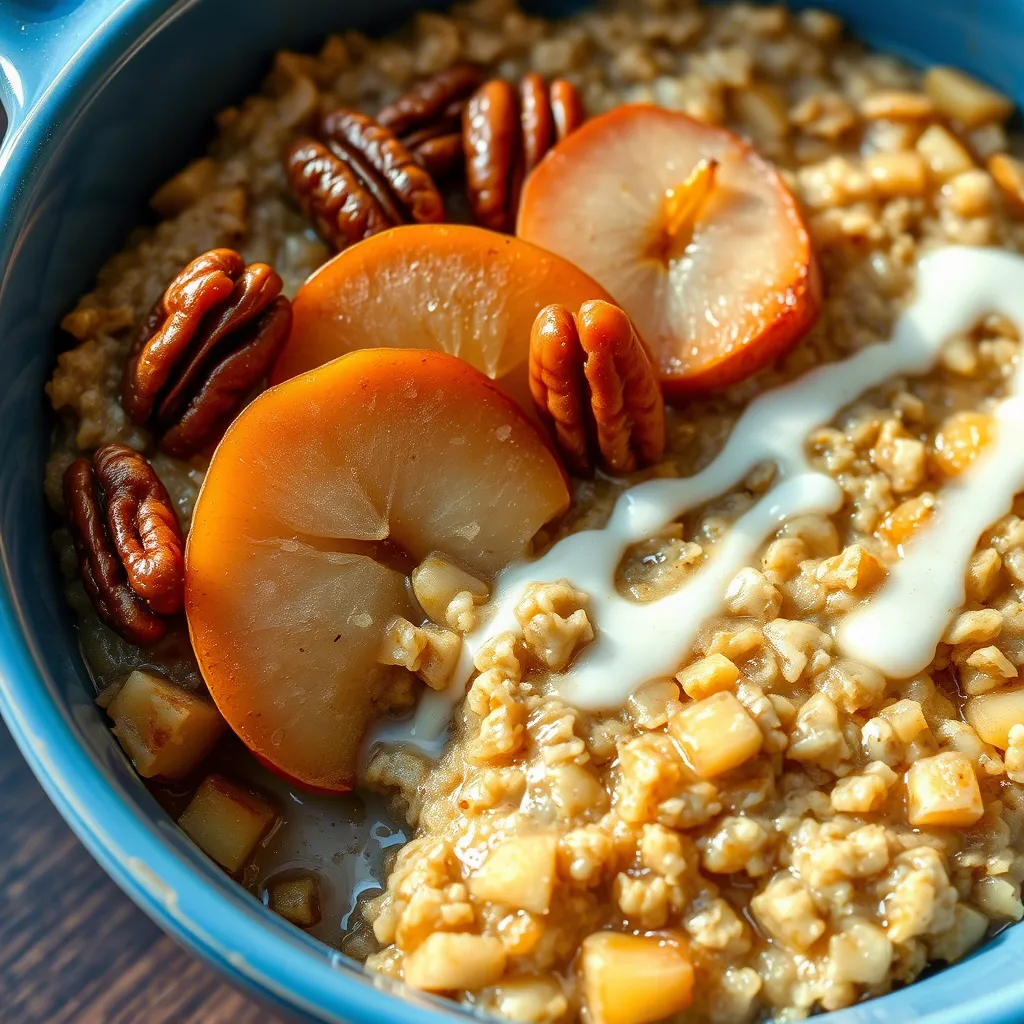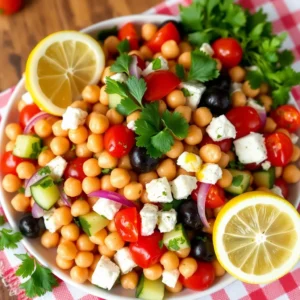Why You’ll Love This Pear and Ginger Baked Oatmeal
Picture this: it’s a chilly winter morning, the kind where your slippers are non-negotiable and that second cup of coffee is already calling your name. Now imagine pulling a bubbling dish of perfectly spiced, golden-topped baked oatmeal from the oven, fragrant with ginger and sweet pears, crowned with maple-glazed pecans. This, my friends, is not just breakfast—it’s morning therapy.
As a busy parent, I know the morning rush all too well. The constant juggling of lunch boxes, permission slips, and “Mom, I can’t find my other sock!” moments. That’s precisely why this baked oatmeal recipe has become my secret weapon. It’s the breakfast that works harder than a double shot of espresso but requires less effort than hitting the snooze button.
Unlike those grab-and-go breakfasts that leave you hungry an hour later, this hearty dish actually sticks with you. The combination of fiber-rich oats and protein from eggs and nuts means you (and those little monsters—I mean, darlings—of yours) will stay fueled through morning meetings or school drop-offs without the mid-morning hunger meltdown.
What really sets this recipe apart is its wonderful balance of flavors and textures. The warmth of ginger plays perfectly against the sweetness of ripe pears, while the maple pecans add a delightful crunch to contrast the creamy oatmeal beneath. It’s like having dessert for breakfast, except you can feel smugly virtuous about all the wholesome ingredients.
For those of you with picky eaters (I see you nodding!), this dish is a game-changer. My youngest used to turn her nose up at oatmeal—”It looks like mush, Dad!”—but something magical happens when it’s baked. The edges get slightly crisp, the top turns golden, and suddenly it’s not “boring old oatmeal” anymore. It’s a special treat worthy of weekend status but easy enough for Tuesday morning.
The real beauty of this baked oatmeal recipe? You can prep it the night before. Just mix the ingredients, cover the dish, refrigerate, and pop it in the oven while you’re getting ready in the morning. By the time everyone’s dressed and somewhat resembling functioning humans, breakfast is served. If that’s not kitchen sorcery, I don’t know what is.
And for those of you watching your nutrition—whether you’re counting macros or just trying to eat more mindfully—this dish hits all the right notes. The oats provide slow-releasing carbs, the eggs and nuts offer protein, and the fruit brings natural sweetness along with vitamins. It’s substantially more satisfying than that sad protein bar you’ve been nibbling on during your commute.
The Story Behind This Pear and Ginger Baked Oatmeal
My journey with this pear and ginger baked oatmeal began during one particularly brutal winter about five years ago. The kind of winter where the sky seems permanently gray and stepping outside feels like walking into a freezer. My usual breakfast rotation was getting stale (quite literally, in the case of that forgotten bagel), and the family was growing restless with the same old, same old.
I’ve always had a soft spot for oatmeal. Growing up, my grandmother would make it on cold mornings, her pot simmering away as she added her “secret ingredients” (which I later discovered was just a generous splash of cream and brown sugar—grandmothers and their adorable “secrets”). But my kids weren’t buying into the traditional bowl of oats, no matter how much maple syrup I drizzled on top.
Then came the winter morning that changed everything. I had a few pears that were on the verge of becoming too ripe, a knob of ginger left from a stir-fry experiment, and a container of oats staring at me from the pantry. Throwing caution to the wind (or more accurately, avoiding a trip to the grocery store in the snow), I decided to try baking the oatmeal instead of the usual stovetop method.
The first attempt was… interesting. Let’s just say the ratio of liquid to oats was a bit off, resulting in something that could have doubled as mortar for a brick wall. But the flavor combination—that was magic from the start. The warming ginger, the sweet pears, the hint of vanilla… even my most skeptical child took a second bite.
Several iterations later, this recipe was born. The turning point was the addition of maple-glazed pecans. It happened by accident, really. I was making maple pecans for a salad later that day and absentmindedly sprinkled some over the oatmeal before baking. That happy accident elevated this dish from “pretty good breakfast” to “Can we have this every day, Dad?”
Now it’s a treasured part of our winter ritual. On Sunday mornings, when the world outside is still quiet and the house is filled with that magical early light, I’ll prep this oatmeal while the kids are still in their pajamas, watching cartoons or building blanket forts. The aroma as it bakes has become our family’s winter perfume—ginger, vanilla, and the sweet smell of pears melding together.
What I love most about this dish is how it brings everyone to the table. In a world where family meals are increasingly rare—everyone rushing off in different directions with different schedules—this baked oatmeal has the power to pause time, just for a little while. There’s something about a warm, home-cooked breakfast that says “I love you” without having to speak the words.
My daughter, now thirteen and firmly in the eye-rolling phase of adolescence, still requests this on her birthday. My son, who claims to be “too busy” for breakfast most days, will magically find time when this is on the menu. And my partner, who typically views breakfast as “optional,” has been known to set an alarm on weekends just to make sure they don’t miss out.
I’ve tweaked this recipe countless times over the years—adding cardamom during the holidays, swapping in apples when pears aren’t at their peak, experimenting with different nuts. But this version, the one I’m sharing with you today, is the one that consistently earns the highest praise in my household. It’s comfort in a baking dish, a warm hug on a cold morning, and proof that sometimes the most ordinary ingredients can create the most extraordinary moments.
Ingredients
Let’s gather everything we need for this glorious winter breakfast that’s about to revolutionize your morning routine. Don’t worry if your pantry isn’t stocked like a gourmet shop—this baked oatmeal recipe is forgiving and flexible, just like your favorite pair of weekend sweatpants.
For the oatmeal base, you’ll need 2 cups of old-fashioned rolled oats. These are the sturdy, whole oats that give this dish its hearty texture. Quick oats will work in a pinch, but they’ll create a softer, less distinct texture. Steel-cut oats, while delicious, need a different liquid ratio and cooking time, so save those for another day. Your regular supermarket variety rolled oats are perfect here—no need to splurge on anything fancy.
Next up: 1/2 cup of brown sugar, packed. The molasses notes in brown sugar pair beautifully with the ginger and pears, but if you’re watching your sugar intake, you can reduce this to 1/3 cup or substitute with coconut sugar or maple sugar for a different dimension of flavor. If you’re out of brown sugar, white sugar with a teaspoon of molasses works wonderfully too.
For leavening and structure, you’ll need 1 teaspoon of baking powder. This gives the oatmeal a slightly cakey quality rather than just being, well, oats in a dish. Make sure your baking powder is fresh—if it’s been lurking in your pantry since last year’s holiday baking frenzy, it might be time for a replacement.
The spice lineup includes 2 teaspoons of ground ginger (the star of our flavor show), 1 teaspoon of cinnamon (ginger’s loyal sidekick), and 1/4 teaspoon of salt (the unsung hero that makes all the other flavors pop). If you have fresh ginger, even better! Substitute with 1 tablespoon of finely grated fresh ginger for a more vibrant zing.
For the wet ingredients, gather 2 large eggs (these bind everything together and add protein), 2 cups of milk (any kind works—dairy, almond, oat, soy), 2 tablespoons of melted butter or coconut oil (for richness), and 1 teaspoon of vanilla extract (because vanilla makes everything better).
Now for our fruit star: 2 ripe pears. Choose pears that yield slightly to pressure but aren’t mushy. Bartlett, Anjou, or Bosc varieties all work beautifully. If pears aren’t available or in season, don’t fret! Apples make an excellent substitute, though they might need an extra few minutes in the oven. You’ll want to dice these into roughly 1/2-inch chunks—not so small that they disappear, but not so large that they take over the dish.
For the maple pecan topping, you’ll need 3/4 cup of pecan halves and 2 tablespoons of pure maple syrup. Please, I beg you, use real maple syrup here, not the pancake syrup that’s essentially flavored corn syrup. The authentic maple flavor is crucial. If pecans aren’t your thing or allergies are a concern, walnuts or almonds make excellent alternatives. For a nut-free version, try pumpkin seeds or a sprinkle of granola.
Optional but highly recommended add-ins include 1/4 cup of crystallized ginger (chopped into small pieces for bursts of intense ginger flavor) and 1/4 cup of dried cranberries or golden raisins for extra sweetness and texture.
You’ll also want to have a bit of extra butter or cooking spray for greasing your baking dish. I recommend an 8×8 inch square dish or a 9-inch round one. Something with 2-inch sides works best to prevent any overflow situations.
The beauty of this baked oatmeal recipe is its adaptability. No pears? Use apples, berries, or even sliced bananas. Out of pecans? Any nut or seed will do. The core formula stays the same, but you can customize based on what’s in your pantry or what flavors you’re craving.
Execution
Alright, let’s get this glorious baked oatmeal into the oven and on its way to becoming the highlight of your morning! The process is straightforward, even if you’re operating on pre-coffee autopilot.
First things first, preheat your oven to 350°F (175°C). This temperature is the sweet spot for baked oatmeal—hot enough to cook everything through and create those lovely golden edges, but not so hot that the outside burns before the inside sets. While the oven is heating up, lightly grease your 8×8 inch baking dish with butter or cooking spray. I prefer butter for the extra flavor it adds, but cooking spray works perfectly fine too.
In a large mixing bowl, combine all your dry ingredients: the 2 cups of rolled oats, 1/2 cup of brown sugar, 1 teaspoon of baking powder, 2 teaspoons of ground ginger, 1 teaspoon of cinnamon, and 1/4 teaspoon of salt. Give these a good whisk to ensure the spices and leavening agent are evenly distributed. There’s nothing worse than getting a bite that’s all baking powder—trust me on this one.
In a separate bowl, beat the 2 eggs until they’re lightly frothy. This helps create a more cake-like texture in your final dish. Then add the 2 cups of milk, 2 tablespoons of melted butter (cooled slightly so it doesn’t cook the eggs on contact), and 1 teaspoon of vanilla extract. Whisk these wet ingredients together until well combined.
Here comes the important part: pour the wet mixture into the dry ingredients and stir gently to combine. Don’t over-mix! We’re not making bread here—a few lumps are perfectly fine. Think of it as folding rather than stirring vigorously. This gentle approach keeps the oatmeal from becoming too dense.
Now, add in the diced pears and any optional add-ins like crystallized ginger or dried cranberries. Fold these in carefully to distribute them throughout the mixture. The goal is to have lovely pear pieces in every serving.
Pour this mixture into your prepared baking dish, spreading it out evenly. If some of the pear pieces poke up through the surface, that’s perfect—they’ll caramelize beautifully during baking.
For the maple pecan topping, simply toss the pecan halves with the maple syrup in a small bowl until they’re evenly coated. Scatter these over the top of your oatmeal mixture, making sure to distribute them evenly. As they bake, the maple syrup will caramelize slightly, creating crunchy, sweet clusters that contrast wonderfully with the soft oatmeal beneath.
Now, slide your creation into the preheated oven and bake for about 35 minutes. You’re looking for the edges to be set and slightly pulling away from the sides of the dish, while the top is golden brown. The center should still have a slight jiggle when you gently shake the dish—it will continue to set as it cools.
While it’s baking, your kitchen will fill with the most amazing aroma—warm spices, sweet pears, and that nutty pecan scent. If your family isn’t already awake, this fragrance will do the trick better than any alarm clock!
Once baked, remove the dish from the oven and let it cool for about 5-10 minutes before serving. This brief resting period allows the oatmeal to set up properly so you can cut neat squares rather than serving a delicious but messy scoop. That said, if you can’t wait and don’t mind a more rustic presentation, dive right in—I certainly won’t judge!
For serving, you can add a drizzle of additional maple syrup, a splash of warm milk, or even a dollop of yogurt for extra creaminess. A sprinkle of fresh fruit on top adds a nice contrast to the warm, baked elements.
If you’re making this ahead of time, let it cool completely before covering it with plastic wrap or transferring portions to airtight containers. It will keep in the refrigerator for up to 5 days, and you can reheat individual portions in the microwave for about 60 seconds with excellent results. Add a splash of milk after reheating to bring back some moisture if needed.
Additional Tips
Now that you’ve mastered the basics of this warming winter breakfast, let me share some insider tips and variations that will help you make this baked oatmeal recipe truly your own. After years of tinkering with this dish, I’ve picked up a few tricks that elevate it from merely delicious to absolutely spectacular.
First, let’s talk make-ahead options because, let’s face it, most of us aren’t functioning at full capacity first thing in the morning. You can prepare the entire mixture the night before, pour it into your baking dish, cover it tightly with plastic wrap, and refrigerate overnight. In the morning, remove it from the fridge while the oven preheats (letting it come closer to room temperature helps it bake more evenly), then uncover and bake as directed. You might need to add an extra 5 minutes to the baking time since you’re starting with a cold dish.
For an even easier morning approach, bake the oatmeal ahead of time, let it cool completely, then cut it into squares. These can be wrapped individually and frozen for up to 3 months. Pop a square in the microwave for about 90 seconds when you’re ready to eat—instant homemade breakfast with zero morning brain power required!
Let’s dive into some seasonal variations that keep this dish exciting year-round. In summer, swap the pears for fresh berries or peaches. Fall calls for apples and a touch more cinnamon, maybe even a pinch of nutmeg. During the holidays, try adding a tablespoon of orange zest and a handful of cranberries for a festive twist that will make your kitchen smell like Christmas morning.
For those watching their sugar intake, you can reduce the brown sugar and rely more on the natural sweetness of very ripe pears. Another trick is to use a very ripe banana mashed into the wet ingredients—it adds sweetness and moisture without refined sugar. Just note that it will impart a banana flavor, which works well with the ginger but changes the profile slightly.
Speaking of dietary considerations, this recipe is incredibly adaptable. Make it dairy-free by using almond milk or oat milk and coconut oil instead of butter. For a vegan version, replace the eggs with flax eggs (1 tablespoon ground flaxseed mixed with 3 tablespoons water for each egg, allowed to sit for 5 minutes before using). The texture will be slightly different but still delicious.
If you’re serving this for a brunch gathering, consider setting up a “baked oatmeal bar” with various toppings so guests can customize their servings. Some winning options include Greek yogurt, fresh berries, sliced bananas, additional maple syrup, honey, nut butters, toasted coconut flakes, or even a sprinkle of dark chocolate chips for the more indulgent brunchers.
For a more dessert-like treat (that’s still breakfast-appropriate, I promise), try topping individual servings with a small scoop of vanilla yogurt or ricotta sweetened with a touch of maple syrup. The contrast of the cold, creamy topping with the warm oatmeal is absolutely divine.
Troubleshooting time! If your oatmeal turns out too dry, you likely measured the oats too generously or the liquid too sparingly. Next time, double-check your measurements or add an extra 1/4 cup of milk. Too wet? It might need a few more minutes in the oven, or you could try reducing the liquid slightly in your next batch.
For storage, this baked oatmeal keeps beautifully in the refrigerator for up to 5 days. The flavors actually develop and meld together over time, making day-two oatmeal sometimes even better than day one. Just cover it tightly once it’s completely cool. For reheating, I recommend the microwave for individual portions (about 45-60 seconds) or the oven at 325°F for about 15-20 minutes if you’re reheating the entire dish.
One final pro tip: if you find yourself with just a small portion left that’s not quite enough for a full serving, crumble it over yogurt for a deconstructed parfait, or even use it as a topping for a scoop of vanilla ice cream. Yes, I’m giving you permission to put breakfast on your dessert. You’re welcome.
FAQs
Can I use quick oats instead of rolled oats in this baked oatmeal recipe?
You can use quick oats, but expect a softer, less distinct texture in the final dish. Quick oats absorb liquid more rapidly than rolled oats, so you might want to reduce the milk slightly—try using 1¾ cups instead of the full 2 cups. The baking time may also be reduced by about 5 minutes, so keep an eye on it. That said, rolled oats (old-fashioned oats) really do give the best texture for this particular dish, providing that perfect balance between chewy and tender.
My family doesn’t like pears. What fruit can I substitute?
Apples work beautifully as a direct substitute for pears in this recipe! Go for a variety that holds its shape when baked, like Honeycrisp, Pink Lady, or Granny Smith if you prefer a more tart contrast to the sweet oatmeal. Other delicious alternatives include peaches in summer, plums in late summer/early fall, or a mix of berries (though berries release more liquid, so you might want to reduce the milk by ¼ cup). For a tropical twist, try using mango chunks and substituting some of the ginger with cardamom—it’s unexpected but absolutely delicious for a winter breakfast with summer vibes.
How do I know when the baked oatmeal is done?
The perfect baked oatmeal should be set around the edges, which will look dry and slightly pulled away from the sides of the baking dish. The center should be mostly set but with a slight jiggle when you gently shake the dish—think the consistency of a just-set custard. The top should be golden brown, and a toothpick inserted in the center should come out mostly clean, perhaps with a few moist crumbs but not wet batter. Remember that the oatmeal will continue to set as it cools, so it’s better to err on the side of slightly underbaked than overbaked, which can result in dry, crumbly oatmeal.
Can I make this oatmeal gluten-free?
Absolutely! Oats are naturally gluten-free, but they’re often processed in facilities that also handle wheat, so cross-contamination can occur. For a truly gluten-free version, make sure to purchase certified gluten-free oats. All the other ingredients in this recipe are naturally gluten-free, but always check packaged items like baking powder and vanilla extract to ensure they don’t contain any gluten-containing additives. With these simple precautions, this winter breakfast is perfect for those avoiding gluten.
How can I increase the protein content in this dish?
There are several easy ways to boost the protein in this baked oatmeal! Try stirring ¼ cup of your favorite protein powder into the dry ingredients (unflavored or vanilla work best). You can also add ¼ cup of nut butter (almond, peanut, or cashew) to the wet ingredients, which adds a lovely richness along with protein. Another option is to increase the eggs to 3 instead of 2, or stir in ½ cup of Greek yogurt along with the milk. For a plant-based protein boost, mix in ¼ cup of hemp seeds or chia seeds with the dry ingredients. These additions make this hearty breakfast even more satisfying and will keep hunger at bay until lunchtime.
What can I use instead of pecans if I have a nut allergy?
For a nut-free version that still provides that delightful crunchy contrast, try using pumpkin seeds (pepitas) or sunflower seeds tossed with the maple syrup. Another excellent option is to create a maple-oat streusel: combine ¼ cup oats, 2 tablespoons flour (any kind), 2 tablespoons maple syrup, and 1 tablespoon melted butter or coconut oil, then sprinkle this over the top before baking. For those who can tolerate coconut (which botanically isn’t a nut), toasted coconut flakes make a wonderful topping and add great texture.
Can this pear ginger baked oatmeal be frozen?
Yes! This baked oatmeal freezes beautifully, making it perfect for meal prep. Allow it to cool completely, then cut into individual portions and wrap each one tightly in plastic wrap, followed by foil or place them in airtight containers. They’ll keep in the freezer for up to 3 months. To reheat, unwrap a portion and microwave it for about 90 seconds to 2 minutes, depending on your microwave’s power. You can also thaw it overnight in the refrigerator and then reheat it in a 350°F oven for about 10 minutes. A quick drizzle of maple syrup or splash of milk after reheating brings it right back to freshly-baked glory!
This baked oatmeal recipe is truly a winter breakfast game-changer, combining the warming flavors of ginger and pears with the irresistible crunch of maple pecans. Whether you’re serving it for a cozy family breakfast or meal-prepping for busy weekdays, it’s a dish that nourishes both body and soul. Don’t forget to customize it to your taste—that’s the beauty of home cooking!



